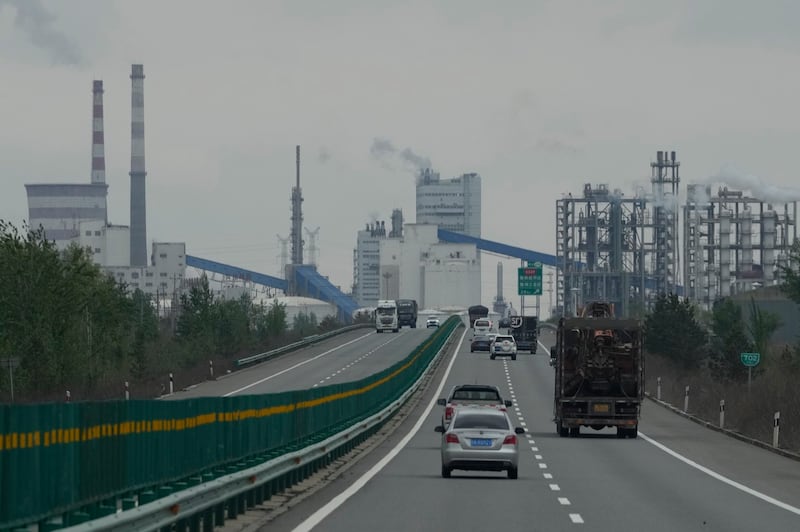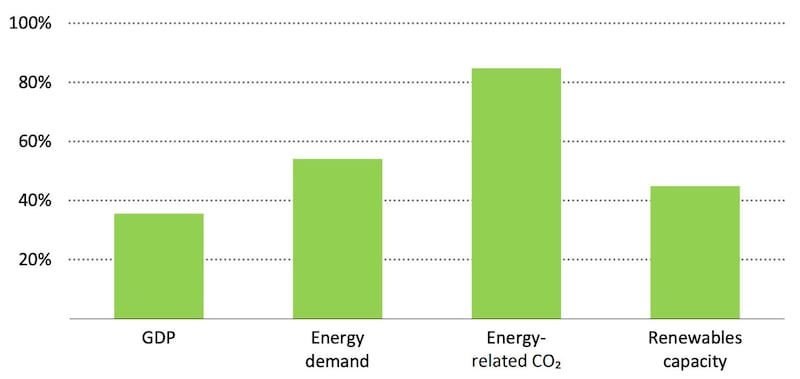The number of electric cars on the road is expected to increase nearly tenfold by 2030, while renewable energy sources will account for almost half of the global power supply, a projection by the International Energy Agency (IEA) said Tuesday.
However, according to the Paris-based intergovernmental organization, China’s peak coal consumption timing is crucial in the global shift to clean energy, as it currently leads all other nations in coal use.
In 2020, one electric vehicle was sold for every 25 cars, while it is one in every five cars in 2023.
By 2030, electric vehicles are projected to account for 40% of global car sales, according to IEA's 2023 World Energy Outlook, one of the most authoritative annual reports on global energy analysis and projections.

The report also projected that a record 500 gigawatts (GW) of renewable generation capacity will be added this year, while more than US$1 billion a day is being spent on solar deployment.
By 2030, renewables are set to contribute 80% of new power capacity. It means they will be responsible for nearly 50% of electricity generated worldwide, up from 30% in 2022, said the report, which was based on current government policies worldwide.
“The transition to clean energy is happening worldwide and it’s unstoppable. It’s not a question of ‘if’, it’s just a matter of ‘how soon’ – and the sooner the better for all of us,” said Fatih Birol, IEA’s executive director.
“Taking into account the ongoing strains and volatility in traditional energy markets today, claims that oil and gas represent safe or secure choices for the world’s energy and climate future look weaker than ever.”
However, despite the positive development, more robust measures are required to keep within reach the Paris Agreement goal of limiting the rise in average global temperatures to 1.5 degrees Celsius, IEA warned, especially as demand for fossil fuels is set to remain “far too high.”
“This risks not only worsening climate impacts after a year of record-breaking heat, but also undermining the security of the energy system, which was built for a cooler world with less extreme weather events,” IEA said in a statement accompanying the report.
Though energy-related carbon emissions might peak in the mid-2020s, emissions remain high enough to push global average temperatures to around 2.4 C in 2100, the report projected.
The IEA also proposed five strategies: tripling renewable capacity, doubling energy efficiency, reducing methane emissions from fossil fuels by 75%, tripling clean energy investments in emerging economies, and gradually declining fossil fuel use.
“The speed at which emissions decline will hinge in large part on our ability to finance sustainable solutions to meet rising energy demand from the world’s fast growing economies,” Birol added.
China, coal and renewables
In 2022, China was the top coal consumer, producer, and importer worldwide, with significant oil and gas consumption, making it the leading global CO2 emitter, responsible for a third of total emissions.
The country’s total CO2 emissions last year amounted to a staggering 12.1 gigaton, two-thirds of which originated from using coal in electricity generation and industrial processes, resulting in 25% of global energy-related emissions.
More than 60% of China’s coal usage was for the power sector, notably lower than the peak of 81% in 2007 and the 20-year average of 73%.
Its surging electricity demand drove an annual increase of almost 40 GW in coal capacity over the past five years, surpassing the rest of the world’s combined additions.
In 2022 alone, China approved around 90 GW of new coal capacity, with an additional 50 GW in planning. Combined with the existing 100 GW under construction by year-end, China’s coal capacity will keep growing through 2030, IEA said.
China will retain its status as “the largest emitter in the world in 2050,” it added.

However, the world’s second-largest economy also leads the global market in several clean energy technologies, with an annual clean energy investment of over $650 billion.
In 2022, it dominated 60% of worldwide electric car sales, contributed half of new wind capacity, and accounted for 45% of global solar photovoltaic (PV) capacity expansions.
By 2050, China will likely have 50% of global solar PV capacity, 40% of wind capacity, one-third of nuclear power capacity, and 40% of the global electric car fleet.
Electric vehicles now command a substantial 29% share of the automotive market, and the rapid progress in clean energy will likely help China achieve its 2030 National Determined Contribution (NDC) goal of 1,200 GW of solar and wind energy capacity five years ahead.
Despite the increasing adoption of clean energy technologies, China is projected to maintain its status as the world’s foremost consumer of fossil fuels until the year 2050. Its coal use is expected to peak around 2025, dropping nearly 30% by 2030 and to 50% by 2050.
Similarly, China’s CO2 emissions peak around 2025, gradually decreasing by approximately 2.3% per year until mid-century, when they reach 7 gigatons, IEA said.
Meanwhile, in Southeast Asia, heavy reliance on fossil fuels has resulted in the region having the highest absolute growth in CO2 emissions worldwide, IEA noted, projecting emissions to rise by 46% by 2050 compared to 2022 levels, primarily due to coal consumption.
The region will continue to expand coal-based electricity generation until 2050, even though its coal’s share falls to less than one-third. It makes the region the second-highest coal-dependent globally by 2050, the report said.
Clean energy investment in Southeast Asia reached nearly $30 billion in 2022, with expectations of doubling by the end of this decade.
Edited by Taejun Kang and Mike Firn.
